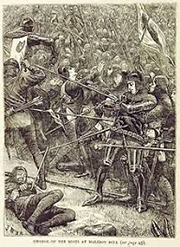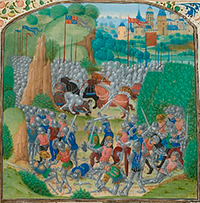King Robert II of Scotland
Robert II was King of Scotland for a time in the 14th Century. His reign took place against the backdrop of continued struggles for supremacy with neighboring England. 
He was born on March 2, 1316 at Paisley Abbey. His mother was Marjorie Bruce, daughter of the famous Robert the Bruce. His father was Walter, 6th High Steward of Scotland. The first holder of this, also named Walter, had adopted the title as his surname, becoming Walter Stewart. When young Robert was just 2, a gathering of Scotland's parliament declared him the successor to his grandfather. However, the birth of the king's son, David, in 1324, meant that Robert was no longer the heir apparent. 
Robert the Bruce died in 1329, and his son became King David II. Just a year after his crowning, David faced an uprising led by Edward Balliol, a son of John Balliol, who was king briefly in the 1290s. Robert fought on his uncle's side, including at the pivotal Battle of Halidon Hill, at which Balliol was accompanied by an army led by England's Edward III. The victory by Balliol and his English allies convinced King David to flee to France. Robert and John Randolph served as Guardians of Scotland. Robert fought with David again in 1346, when Scottish forces invaded northern England. The English victory at the Battle of Neville's Cross resulted in David's capture; in his absence, Robert accepted the regency. Robert rebelled against his uncle in 1363 and was imprisoned. King David II died in 1371, having had no children. Robert, who had been released from prison shortly beforehand, succeeded him and was crowned at Scone in March. He was the first of the House of Stewart, which would rule Scotland for more than two centuries. Unlike David, Robert had plenty of children, 10 in all. Their mother was Elizabeth Mure, whom Robert had not married until after all the children were born. Robert and Elizabeth were married in 1349. Because the children were born when their parents were not married, many nobles considered the children not fit for succeeding their father on the throne. Nonetheless, Robert declared that his firstborn son, John, was his heir apparent. John was at the time High Steward of Scotland. Robert's wife, Elizabeth, died in 1355. He married again, that same year, to Euphemia of Ross, the daughter of Hugh, Earl of Ross. Robert and Euphemia had four children. In 1384, representatives of England and France declared a truce that was meant to include Scotland as well. Scottish forces, whether they knew about the truce or not, attacked English-held territories and seized land and castles. After a few retaliatory strikes by both England and Scotland, the two sides agreed to the truce. In that same year, Scotland's ruling council, angry at Robert's inability to control the increasingly violent activities of his son Alexander in the north, stripped the king of his power and put in the hands of his oldest son, John, Earl of Carrick. 
One highlight in the 14th Century struggles between England and Scotland was the Scottish victory in 1388 at the Battle of Otterburn. This victory, near Newcastle, was at the expense of Northumberland's Henry Percy, known as "Hotspur." Leading the Scottish forces was James, Earl of Douglas, who died in the fighting. Douglas had been Carrick's main supporter, and the king's eldest, crippled from a fall from a horse, lost enough other support that he was replaced as the effective head of the country by his younger brother Robert, Earl of Fife. When Robert II died in 1390, his oldest son, Carrick, succeeded him on the throne, not as King John II but as King Robert III. |
|
Social Studies for Kids
copyright 2002–2025
David White




